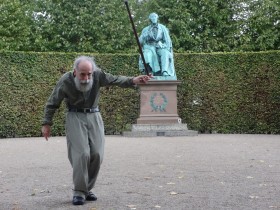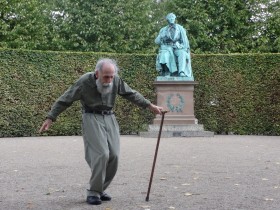Signe Byrge Sørensen modtog i aftes på Filmhøjskolen i Ebeltoft under det årlige branchetræf for dokumentarfilmfolk ROOS PRISEN. Det Danske Filminstitut skriver i den anledning:
“Producer Signe Byrge Sørensen er på vej til internationale festivaler i Venedig og Toronto med sin nye dokumentarfilm “The Look of Silence”, Joshua Oppenheimers opfølger til “The Act of Killing”, der denne gang giver stemme til ofrene for det indonesiske folkemord i 1965-66.
Signe Byrge Sørensen grundlagde Final Cut for real i 2009. At hun kun fem år senere skulle optræde på den mest glamourøse af Hollywoods røde løbere, oscarnomineret for den kontroversielle “The Act of Killing”, havde den beskedne producer nok ikke forestillet sig. Men udsynet og lysten til at formidle globale problematikker på film har været en drivkraft i hele Signe Byrge Sørensens professionelle liv. Det samfundsmæssige engagement kombineret med en enorm arbejdsomhed, analytisk skarphed og stort mod har gjort hende til en dybt respekteret producer blandt kolleger i både Danmark og udlandet.
VISIONÆR PRODUCER I VERDENSKLASSE
Roos Prisen gives for en bemærkelsesværdig indsats for dansk dokumentarfilm, og priskomiteen uddyber valget af den 44-årige producer således:
En filmproducer kan være – men er ikke nødvendigvis – en kreativt drivende kraft. Signe Byrge Sørensen er meget mere end en kreativ producer. Hun har med “The Act of Killing” vist sig som visionær producer i verdensklasse. Hun så potentialet i Joshua Oppenheimers materiale, der bestod af mere end 1000 timers optagelser. Hun etablerede et professionelt, kreativt rum omkring ham, som gjorde, at det monstrøse materiale kunne forløses til en film, der på alle måder er nyskabende og bemærkelsesværdig. Hun skabte det økonomiske rum, og hun sørgede med en vedholdende strategisk indsats for, at filmen kom ud i verden og fik den fortjente opmærksomhed fra både kritikere, publikum og politikere.
Blandt kolleger i filmbranchen bliver Signe Byrge Sørensen fremhævet for sit intellekt, sin seriøsitet, sin fordomsfrihed og enorme vedholdenhed. Hvis Signe har påtaget sig en opgave, tager hun det fulde ansvar: det produktionsmæssige, det kreative, det etiske, det politiske osv. Og man skal absolut ikke lade sig narre af den ydmyge fremtoning. Signe Byrge Sørensen ved, hvad hun vil opnå, og går venligt, men bestemt efter det.
For os alle er det en gave, at det, som Signe Byrge Sørensen overordnet går efter, er at bidrage til en bedre verden med større lighed og social retfærdighed. Med film, der indimellem slår benene væk under publikum. Produceren selv står fast, hvad enten det er på den røde løber eller blandt syriske flygtninge, som er tema for et af Signes kommende filmprojekter.
OM SIGNE BYRGE SØRENSEN
Signe Byrge Sørensen er født i 1970. Opvokset i Maribo, cand.comm. i internationale udviklingsstudier og kommunikation fra RUC i 1998. Hun har produceret film siden 1998. Hun begyndte hos SPOR Media, rykkede senere til Final Cut Productions og grundlagde Final Cut for Real i 2009. Hun har produceret dokumentarfilm over hele verden og modtog i 2014 Timbuktu-prisen for sin formidling af stof fra udviklingslande.
Blandt de film, som Signe Byrge Sørensen har produceret, er “The Look of Silence” (instr. Joshua Oppenheimer, 2014), “Kulturkatedraler: Halden fængsel” (instr. Michael Madsen, 2014), “The Act of Killing” (instr. Joshua Oppenheimer, 2012), “Klovn for livet” (instr. Ida Grøn, 2011), “Hjemvendt” (instr. Marianne Hougen-Moraga, 2011) og “Fodbold er Gud” (instr. Ole Bendtzen, 2010). Hun har også produceret og med-instrueret (med Janus Billeskov Jansen) “I sproget er jeg” (2005) og “Kunsten at være Mlabri” (2007).
OM ROOS PRISEN
Roos Prisen, der er opkaldt efter dokumentarfilmpioneren Jørgen Roos, blev etableret i 1995 med det formål at “påskønne en særlig bemærkelsesværdig indsats for dokumentarismen i Danmark.”
Tidligere prismodtagere er: Jørgen Roos, Jørgen Leth, Sami Saif, Phie Ambo, Janus Billeskov Jansen, Jon Bang Carlsen, Jesper Jargil, Anne Wivel, Tue Steen Müller, Niels Pagh Andersen, Arne Bro, Steen Møller Rasmussen, Tine Fischer, duoen Lise Lense-Møller og Anders Østergaard, Lars Skree, Eva Mulvad, Michael Noer og Adam Nielsen.
Priskomiteen består af sidste års modtager, Adam Nielsen, samt direktør Henrik Bo Nielsen og udviklingschef Ane Mandrup fra Det Danske Filminstitut.”
http://www.filmkommentaren.dk/blog/blogpost/2163/
http://www.filmkommentaren.dk/blog/blogpost/2729/






